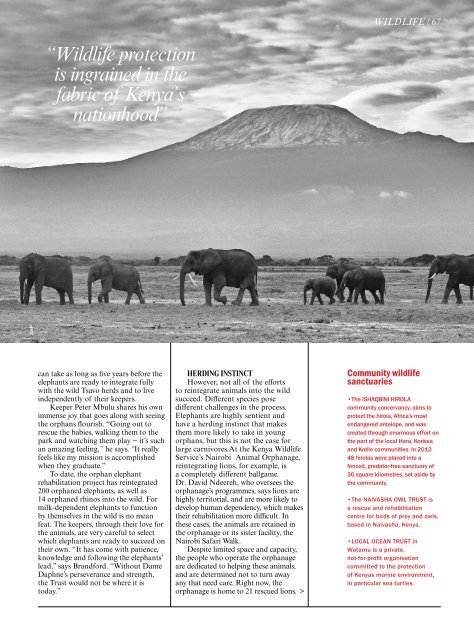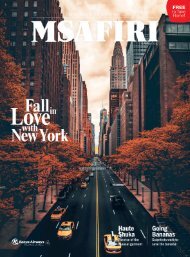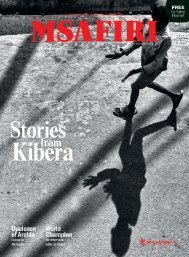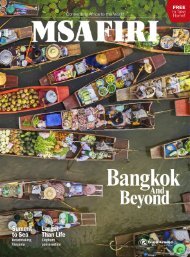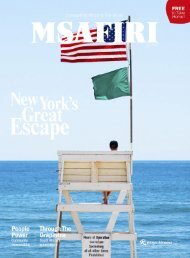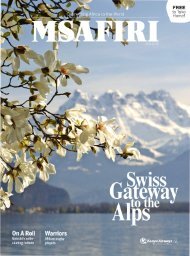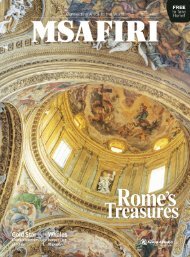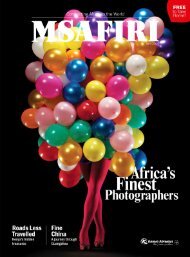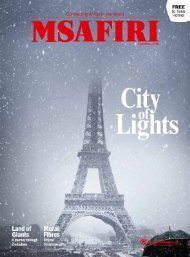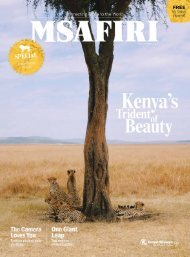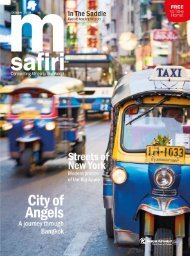Create successful ePaper yourself
Turn your PDF publications into a flip-book with our unique Google optimized e-Paper software.
WILDLIFE / 67<br />
“Wildlife protection<br />
is ingrained in the<br />
fabric of Kenya’s<br />
nationhood”<br />
ANP<br />
can take as long as five years before the<br />
elephants are ready to integrate fully<br />
with the wild Tsavo herds and to live<br />
independently of their keepers.<br />
Keeper Peter Mbulu shares his own<br />
immense joy that goes along with seeing<br />
the orphans flourish. “Going out to<br />
rescue the babies, walking them to the<br />
park and watching them play − it’s such<br />
an amazing feeling,” he says. “It really<br />
feels like my mission is accomplished<br />
when they graduate.”<br />
To date, the orphan elephant<br />
rehabilitation project has reintegrated<br />
200 orphaned elephants, as well as<br />
14 orphaned rhinos into the wild. For<br />
milk-dependent elephants to function<br />
by themselves in the wild is no mean<br />
feat. The keepers, through their love for<br />
the animals, are very careful to select<br />
which elephants are ready to succeed on<br />
their own. “It has come with patience,<br />
knowledge and following the elephants’<br />
lead,” says Brandford. “Without Dame<br />
Daphne’s perseverance and strength,<br />
the Trust would not be where it is<br />
today.”<br />
HERDING INSTINCT<br />
However, not all of the efforts<br />
to reintegrate animals into the wild<br />
succeed. Different species pose<br />
different challenges in the process.<br />
Elephants are highly sentient and<br />
have a herding instinct that makes<br />
them more likely to take in young<br />
orphans, but this is not the case for<br />
large carnivores.At the Kenya Wildlife<br />
Service’s Nairobi Animal Orphanage,<br />
reintegrating lions, for example, is<br />
a completely different ballgame.<br />
Dr. David Ndeereh, who oversees the<br />
orphanage’s programmes, says lions are<br />
highly territorial, and are more likely to<br />
develop human dependency, which makes<br />
their rehabilitation more difficult. In<br />
these cases, the animals are retained in<br />
the orphanage or its sister facility, the<br />
Nairobi Safari Walk.<br />
Despite limited space and capacity,<br />
the people who operate the orphanage<br />
are dedicated to helping these animals,<br />
and are determined not to turn away<br />
any that need care. Right now, the<br />
orphanage is home to 21 rescued lions. ><br />
Community wildlife<br />
sanctuaries<br />
•The ISHAQBINI HIROLA<br />
community concervancy, aims to<br />
protect the hirola, Africa’s most<br />
endangered antelope, and was<br />
created through enormous effort on<br />
the part of the local Hara, Korissa<br />
and Kotile communities. In 2012<br />
48 hirolas were placed into a<br />
fenced, predator-free sanctuary of<br />
30 square kilometres, set aside by<br />
the community.<br />
•The NAIVASHA OWL TRUST is<br />
a rescue and rehabilitation<br />
centre for birds of prey and owls,<br />
based in Naivasha, Kenya.<br />
•LOCAL OCEAN TRUST in<br />
Watamu is a private,<br />
not-for-profit organisation<br />
committed to the protection<br />
of Kenyas marine environment,<br />
in particular sea turtles.


